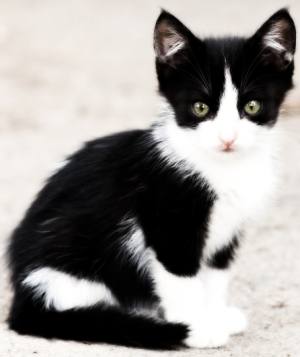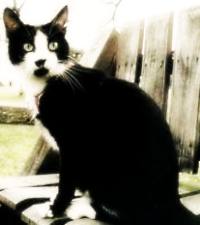The Tuxedo Cat is Not a Breed!

The tuxedo cat is in fact, not a breed at all, but a black and white bicolor coat pattern.
Those with a special place in their hearts for these cats will sometimes name their "tuxies" with their coat patterns in mind.
The discussion on coat types, patterns and colors gets a little muddy depending upon what sources you trust.
The book, For the Love of Cats (by Amy Shojai and Irene Gizzi) defines it this way:
A cat with a coat that has some white in it is considered parti-color.
The Cat Fanciers' Association defines parti-color and bi-color like so:
A "parti-colored" cat is a cat with more than one color present. Included in this descriptor group is tortoiseshell, blue cream, lavender cream, calico, (and depending on which breed one is talking about) bi-color, and tabby and white.
A "bi-color" is a parti-colored cat with solid areas of white and another color and/or pattern (such as the color red or a tabby pattern).
So, tuxies are bicolors (in this case, black and white), which is a type of parti-color coat pattern.
A black-over-white (one-third white) bicolor coat is your "typical" tuxedo. The black fur covers most of the back and the tail. They often have a white face with a black "mask" effect.
Some of them will have black spots on their faces, or a "goatee" effect of black on the chin. In addition, they have a white underbelly (chest and abdomen), and lower legs and paws.
Due to the association of tuxedos with formal occasions, some people say that tuxedo cats have "class."
Tuxedo Cats in Breeds
Different countries and registries define breed, color, and coat standards a little differently. The CFA, for example, has an interesting story of the history of parti-color Persians. This description doesn't mention any requirement, however, for white.
Some breeds are accepted in bicolor black and white by certain associations of the cat fancy. Many black and white cats are accepted for showing even if the pattern differs from that of a tuxedo pattern.
Breed identity is defined by each registry, but some of the breeds accepted in black and white are the Manx, the Persian, the Norwegian Forest Cat, and the Maine Coon.
Famous Tuxedo Cats

First cat socks entered the White House when President Bill Clinton took office in 1993.
There hadn't been a cat in the White House for 12 years (Since Amy Carter's Siamese cat, Misty Malarky Ying Yang, vacated the position).
Socks had his own newsletter and fan club.

Sylvester, of Warner Brothers Looney Tunes fame. Sylvester has been chasing Tweety Bird since 1945.
Of course, he is always unsuccessful. This either makes him the most persistent cat in the world, or the worst hunter of the feline species, or both.
He may, however, actually be the most well known and famous tuxedo adorned kitty ever.
Jellicle Cats
The term "Jellicle cat" was made famous in the Andrew Lloyd Webber musical, CATS. CATS is based on T.S. Eliot's (much older) collection of poems, Old Possum's Book of Practical Cats. The musical, however, doesn't strictly follow the original work upon which it is based.
According to Eliot's poem, The Song of the Jellicles these cats are black and white, smallish, have cheerful faces, and pleasant voices.
They rest during the day, and come out at night and dance under the Jellicle Moon at the Jellicle Ball. In Lord Webber's musical, however, the Jellicles are not strictly black and white, but exhibit a variety of coat patterns.
Topics Related to Tuxedo Cat
The calico cat is another coat pattern and not a breed
Tabby is also a coat pattern, and it comes in many colors. Some bicolors can have tabby patterns
Books on felines, including information on breeds, coats, and colors



Comments: What do you think?
Have your say about what you just read. Leave me a comment in the box below.